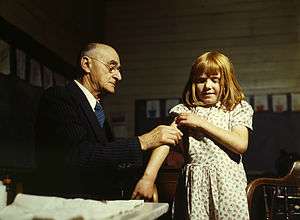Vaccination
| Vaccination | |
|---|---|
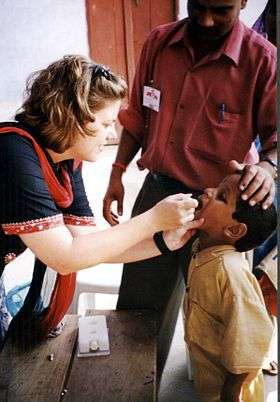 Child receiving an oral polio vaccine | |
| ICD-9-CM | 99.3-99.5 |
Vaccination is the administration of antigenic material (a vaccine) to stimulate an individual's immune system to develop adaptive immunity to a pathogen. Vaccines can prevent or ameliorate infectious disease. When a sufficiently large percentage of a population has been vaccinated, herd immunity results. The effectiveness of vaccination has been widely studied and verified.[1][2][3] Vaccination is the most effective method of preventing infectious diseases;[4] widespread immunity due to vaccination is largely responsible for the worldwide eradication of smallpox and the elimination of diseases such as polio, measles, and tetanus from much of the world.
Smallpox was most likely the first disease people tried to prevent by inoculation[5][6] and was the first disease for which a vaccine was produced. The smallpox vaccine was invented in 1796 by English physician Edward Jenner and although at least six people had used the same principles years earlier he was the first to publish evidence that it was effective and to provide advice on its production.[7] Louis Pasteur furthered the concept through his work in microbiology. The immunization was called vaccination because it was derived from a virus affecting cows (Latin: vacca 'cow').[5][7] Smallpox was a contagious and deadly disease, causing the deaths of 20–60% of infected adults and over 80% of infected children.[8] When smallpox was finally eradicated in 1979, it had already killed an estimated 300–500 million people[9][10][11] in the 20th century.
In common speech, vaccination and immunization have a similar meaning. This distinguishes it from inoculation, which uses unweakened live pathogens, although in common usage either can refer to an immunization. Vaccination efforts have been met with some controversy on scientific, ethical, political, medical safety, and religious grounds. In rare cases, vaccinations can injure people.[12] In the United States, people may receive compensation for those injuries under the National Vaccine Injury Compensation Program. Early success brought widespread acceptance, and mass vaccination campaigns have greatly reduced the incidence of many diseases in numerous geographic regions.
Mechanism of function

Generically, the process of artificial induction of immunity, in an effort to protect against infectious disease, works by 'priming' the immune system with an 'immunogen'. Stimulating immune responses with an infectious agent is known as immunization. Vaccination includes various ways of administering immunogens.[13]
Some vaccines are administered after the patient already has contracted a disease. Vaccines given after exposure to smallpox, within the first three days, are reported to attenuate the disease considerably, and vaccination up to a week after exposure probably offers some protection from disease or may reduce the severity of disease.[14] The first rabies immunization was given by Louis Pasteur to a child after he was bitten by a rabid dog. Since then, it has been found that, in people with healthy immune systems, four doses of rabies vaccine over 14 days, wound care, and treatment of the bite with rabies immune globulin, commenced as soon as possible after exposure, is effective in preventing rabies in humans.[15] Other examples include experimental AIDS, cancer and Alzheimer's disease vaccines. Such immunizations aim to trigger an immune response more rapidly and with less harm than natural infection.
Most vaccines are given by hypodermic injection as they are not absorbed reliably through the intestines. Live attenuated polio, some typhoid, and some cholera vaccines are given orally to produce immunity in the bowel. While vaccination provides a lasting effect, it usually takes several weeks to develop, while passive immunity (the transfer of antibodies) has immediate effect.[16]
Vaccination versus inoculation
The term inoculation is often used interchangeably with vaccination. However, some argue that the terms are not synonymous. Dr Byron Plant explains: "Vaccination is the more commonly used term, which actually consists of a 'safe' injection of a sample taken from a cow suffering from cowpox... Inoculation, a practice probably as old as the disease itself, is the injection of the variola virus taken from a pustule or scab of a smallpox sufferer into the superficial layers of the skin, commonly on the upper arm of the subject. Often inoculation was done 'arm to arm' or less effectively 'scab to arm'..." Inoculation oftentimes caused the patient to become infected with smallpox, and in some cases the infection turned into a severe case.[17][18]
Vaccinations began in the 18th century with the work of Edward Jenner and the smallpox vaccine.[19][20][21]
Side effects
The Centers for Disease Control and Prevention (CDC) has compiled a list of vaccines and their possible side effects.[22] Allegations of vaccine injuries in recent decades have appeared in litigation in the U.S. Some families have won substantial awards from sympathetic juries, even though most public health officials have said that the claims of injuries were unfounded.[23] In response, several vaccine makers stopped production, which the US government believed could be a threat to public health, so laws were passed to shield manufacturers from liabilities stemming from vaccine injury claims.[23] The safety and side effects of multiple vaccines have been tested in order to uphold the viability of vaccines as a barrier against disease. The Influenza vaccine was tested in controlled trials and proven to have negligible side effects equal to that of a placebo.[24] Some concerns from families might have arisen from social beliefs and norms that cause them to mistrust or refuse vaccinations, contributing to this discrepancy in side effects that were unfounded.[25]
History

It is known that the process of inoculation was used by Chinese physicians in the 10th century.[26] Scholar Ole Lund comments: "The earliest documented examples of vaccination are from India and China in the 17th century, where vaccination with powdered scabs from people infected with smallpox was used to protect against the disease. Smallpox used to be a common disease throughout the world and 20 to 30% of infected persons died from the disease. Smallpox was responsible for 8 to 20% of all deaths in several European countries in the 18th century. The tradition of vaccination may have originated in India in AD 1000."[27] The mention of inoculation in the Sact'eya Grantham, an Ayurvedic text, was noted by the French scholar Henri Marie Husson in the journal Dictionaire des sciences médicales.[28] However, the idea that inoculation originated in India has been challenged, as few of the ancient Sanskrit medical texts described the process of inoculation.[29] Accounts of inoculation against smallpox in China can be found as early as the late 10th century and was reportedly widely practised in China in the reign of the Longqing Emperor (r. 1567–72) during the Ming Dynasty (1368–1644).[30] Two reports on the Chinese practice of inoculation were received by the Royal Society in London in 1700; one by Dr. Martin Lister who received a report by an employee of the East India Company stationed in China and another by Clopton Havers.[31] According to Voltaire (1742), the Turks derived their use of inoculation to neighbouring Circassia. Voltaire does not speculate on where the Circassians derived their technique from, though he reports that the Chinese have practiced it "these hundred years".[32] The Greek physicians Emmanuel Timonis (1669–1720) from the island of Chios and Jacob Pylarinos (1659–1718) from Cephalonia practised smallpox inoculation at Constantinople in the beginning of 18th century[33] and published their work in Philosophical Transactions of the Royal Society in 1714.[34][35] This kind of inoculation and other forms of variolation were introduced into England by Lady Montagu, a famous English letter-writer and wife of the English ambassador at Istanbul between 1716 and 1718, who almost died from smallpox as a young adult and was physically scarred from it. Inoculation was adopted both in England and in America nearly half a century before Jenner's famous smallpox vaccine of 1796[36] but the death rate of about 2% from this method meant that it was mainly used during dangerous outbreaks of the disease and remained controversial.[26] It was noticed during the 18th century that people who had suffered from the less virulent cowpox were immune to smallpox, and the first recorded use of this idea was by a farmer Benjamin Jesty at Yetminster in Dorset, who had suffered the disease and transmitted it to his own family in 1774, his sons subsequently not getting the mild version of smallpox when later inoculated in 1789.
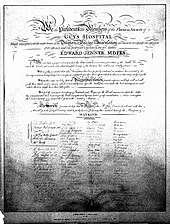

It was Edward Jenner, a doctor in Berkeley in Gloucestershire, who established the procedure by introducing material from a cowpox vesicle on Sarah Nelmes, a milkmaid, into the arm of a boy named James Phipps. Two months later he inoculated the boy with smallpox and the disease did not develop. In 1798 Jenner published An Inquiry into the Causes and Effects of the Variolae Vacciniae, which coined the term vaccination and created widespread interest. He distinguished 'true' and 'spurious' cowpox (which did not give the desired effect) and developed an "arm-to-arm" method of propagating the vaccine from the vaccinated individual's pustule. Early attempts at confirmation were confounded by contamination with smallpox, but despite controversy within the medical profession and religious opposition to the use of animal material, by 1801 his report was translated into six languages and over 100,000 people were vaccinated.[26]
Since then vaccination campaigns have spread throughout the globe, sometimes prescribed by law or regulations (See Vaccination Acts). Vaccines are now used against a wide variety of diseases. Louis Pasteur further developed the technique during the 19th century, extending its use to killed agents protecting against anthrax and rabies. The method Pasteur used entailed treating the agents for those diseases so they lost the ability to infect, whereas inoculation was the hopeful selection of a less virulent form of the disease, and Jenner's vaccination entailed the substitution of a different and less dangerous disease. Pasteur adopted the name vaccine as a generic term in honour of Jenner's discovery.
Maurice Hilleman was the most prolific vaccine inventor, developing successful vaccines for measles, mumps, hepatitis A, hepatitis B, chickenpox, meningitis, pneumonia and 'Haemophilus influenzae'.[37]
In modern times, the first vaccine-preventable disease targeted for eradication was smallpox. The World Health Organization (WHO) coordinated this global eradication effort. The last naturally occurring case of smallpox occurred in Somalia in 1977. In 1988, the governing body of WHO targeted polio for eradication by 2000. Although the target was missed, eradication is very close.
In 2000, the Global Alliance for Vaccines and Immunization was established to strengthen routine vaccinations and introduce new and under-used vaccines in countries with a per capita GDP of under US $1000.
Society and culture
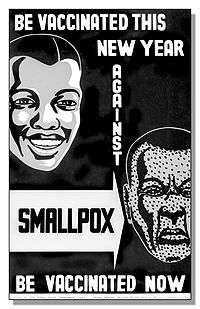
To eliminate the risk of outbreaks of some diseases, at various times governments and other institutions have employed policies requiring vaccination for all people. For example, an 1853 law required universal vaccination against smallpox in England and Wales, with fines levied on people who did not comply. Common contemporary U.S. vaccination policies require that children receive recommended vaccinations before entering public school.
Beginning with early vaccination in the nineteenth century, these policies were resisted by a variety of groups, collectively called antivaccinationists, who object on scientific, ethical, political, medical safety, religious, and other grounds. Common objections are that vaccinations do not work, that compulsory vaccination constitutes excessive government intervention in personal matters, or that the proposed vaccinations are not sufficiently safe.[38] Many modern vaccination policies allow exemptions for people who have compromised immune systems, allergies to the components used in vaccinations or strongly held objections.[39]
In countries with limited financial resources, limited vaccination coverage results in greater morbidity and mortality due to infectious disease.[40] More affluent countries are able to subsidize vaccinations for at-risk groups, resulting in more comprehensive and effective coverage. In Australia, for example, the Government subsidizes vaccinations for seniors and indigenous Australians.[41]
Public Health Law Research, an independent US based organization, reported in 2009 that there is insufficient evidence to assess the effectiveness of requiring vaccinations as a condition for specified jobs as a means of reducing incidence of specific diseases among particularly vulnerable populations;[42] that there is sufficient evidence supporting the effectiveness of requiring vaccinations as a condition for attending child care facilities and schools;[43] and that there is strong evidence supporting the effectiveness of standing orders, which allow healthcare workers without prescription authority to administer vaccine as a public health intervention.[44]
Opposition to vaccination

Opposition to vaccination, from a wide array of vaccine critics, has existed since the earliest vaccination campaigns.[38] Although the benefits of preventing serious illness and death from infectious diseases greatly outweigh the risks of rare serious adverse effects following immunization,[45] disputes have arisen over the morality, ethics, effectiveness, and safety of vaccination. Some vaccination critics say that vaccines are ineffective against disease[46] or that vaccine safety studies are inadequate.[46] Some religious groups do not allow vaccination,[47] and some political groups oppose mandatory vaccination on the grounds of individual liberty.[38] In response, concern has been raised that spreading unfounded information about the medical risks of vaccines increases rates of life-threatening infections, not only in the children whose parents refused vaccinations, but also in those who cannot be vaccinated due to age or immunodeficiency, who could contract infections from unvaccinated carriers (see herd immunity).[48] Some parents believe vaccinations cause autism, although there is no scientific evidence to support this idea.[49] In 2011, Andrew Wakefield, a leading proponent of the theory that MMR vaccine causes autism, was found to have been financially motivated to falsify research data and was subsequently stripped of his medical license.[50] In the United States people who refuse vaccines for non-medical reasons have made up a large percentage of the cases of measles, and subsequent cases of permanent hearing loss and death caused by the disease.[51]
Vaccination-autism controversy
In the MMR vaccine controversy, a fraudulent 1998 paper by Andrew Wakefield, originally published in The Lancet, presented falsified evidence that the MMR vaccine (an immunization against measles, mumps and rubella that is typically first administered to children shortly after their first birthday) was linked to the onset of autism spectrum disorders.[52] The article was widely criticized for lack of scientific rigour, partially retracted in 2004 by Wakefield's co-authors,[53] and was fully retracted by The Lancet in 2010.[54] Wakefield was struck off the UK's medical registry for the fraud.[55]
This Lancet article has sparked a much greater anti-vaccination movement, primarily in the United States. Even though the article was fraudulent and was retracted, 1 in 4 parents still believe vaccines can cause autism.[56]
Many parents do not vaccinate their children because they feel that diseases are no longer present due to vaccination.[57] This is a false assumption, since diseases held in check by immunization programs can and do still return if immunization is dropped. These pathogens could possibly infect vaccinated people, due to the pathogen's ability to mutate when it is able to live in unvaccinated hosts. In 2010, California had the worst whooping cough outbreak in 50 years. A possible contributing factor was parents choosing not to vaccinate their children.[58] There was also a case in Texas in 2012 where 21 members of a church contracted measles because they chose not to immunize.[58]
Routes of administration
A vaccine administration may be oral, by injection (intramuscular, intradermal, subcutaneous), by puncture, transdermal or intranasal.[59] Several recent clinical trials have aimed to deliver the vaccines via mucosal surfaces to be up-taken by the common mucosal immunity system, thus avoiding the need for injections.[60]
Global trends in vaccination
The World Health Organization (WHO) estimate that vaccination averts 2-3 million deaths per year (in all age groups), and up to 1.5 million children die each year due to diseases which could have been prevented by vaccination.[61] They estimate that 29% of deaths of children under five years old in 2013 were vaccine preventable. In other developing parts of the world, they are faced with the challenge of having a decreased availability of resources and vaccinations. Countries such as those in Sub-Saharan Africa cannot afford to provide the full range of childhood vaccinations.[62]
- Vaccination in art
 La vaccine or Le préjugé vaincu by Louis-Léopold Boilly, 1807
La vaccine or Le préjugé vaincu by Louis-Léopold Boilly, 1807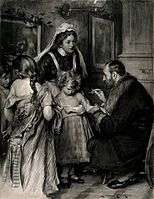 A doctor vaccinating a small girl, other girls with loosened blouses wait their turn apprehensively by Lance Calkin
A doctor vaccinating a small girl, other girls with loosened blouses wait their turn apprehensively by Lance Calkin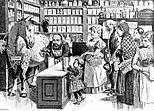 German caricature showing von Behring extracting the serum with a tap.
German caricature showing von Behring extracting the serum with a tap.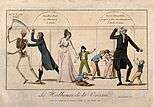 Les Malheurs de la Vaccine (The history of vaccination seen from an economic point of view: A pharmacy up for sale; an outmoded inoculist selling his premises; Jenner, to the left, pursues a skeleton with a lancet)
Les Malheurs de la Vaccine (The history of vaccination seen from an economic point of view: A pharmacy up for sale; an outmoded inoculist selling his premises; Jenner, to the left, pursues a skeleton with a lancet)
United States
Vaccines have led to major decreases in the prevalence of infectious diseases in the United States. In 2007, studies regarding the effectiveness of vaccines on mortality or morbidity rates of those exposed to various diseases have shown almost 100% decreases in death rates, and about a 90% decrease in exposure rates.[63] This has allowed specific organizations and states to adopt standards for recommended early childhood vaccinations. Lower income families who are unable to otherwise afford vaccinations are supported by these organizations and specific government laws. The Vaccine for Children Program and the Social Security Act are two major players in supporting lower socioeconomic groups.
Economics of Vaccination
Health is often used as one of the metrics for determining the economic prosperity of a country. This is because healthier individuals are generally better suited to contributing to the economic development of a country than the sick.[64] There are many reasons for this. A person who is vaccinated for influenza, not only protects himself from the risk of influenza, but, simultaneously, prevents himself from infecting those around him.[65] This leads to a healthier society, which allows individuals to be more economically productive. Children are consequently able to attend school more often and have been shown to do better academically. Similarly, adults are able to work more often, more efficiently, and more effectively.[66][67]
Costs and Benefits
On the whole, vaccinations induce a net benefit to society. Vaccines are often noted for their high return on investment (ROI) values, especially when considering the long-term effects.[68] Some vaccines have much higher ROI values than others.
Studies have shown that the ratios of vaccination benefits to costs can vary substantially--from 27:1 for diphtheria/pertussis, to 13.5:1 for measles, 4.76:1 for varicella, and 0.68:1-1.1:1 for pneumococcal conjugate.[65]
Some governments choose to subsidize the costs of vaccines, due to some of the high ROI values attributed to vaccinations.The United States subsidizes over half of all vaccines for children, which costs between $400 and $600 each. Although most children do get vaccinated, the adult population is still below the recommended immunization levels. Many factors can be attributed to this issue. Many adults who have other health conditions are unable to be safely immunized, whereas others opt not to be immunized for the sake of private financial benefits. Many Americans are underinsured, and, as such, are required to pay for vaccines out-of-pocket. Others are responsible for paying high deductibles and co-pays. Although vaccinations usually induce long-term economic benefits, many governments struggle to pay the high short-term costs associated with labor and production. Consequently, many countries neglect to provide such services.[65]
See also
References
- ↑ Fiore AE, Bridges CB, Cox NJ (2009). Seasonal influenza vaccines. Current Topics in Microbiology and Immunology. 333. pp. 43–82. doi:10.1007/978-3-540-92165-3_3. ISBN 978-3-540-92164-6. PMID 19768400.
- ↑ Chang Y, Brewer NT, Rinas AC, Schmitt K, Smith JS (July 2009). "Evaluating the impact of human papillomavirus vaccines". Vaccine. 27 (32): 4355–62. doi:10.1016/j.vaccine.2009.03.008. PMID 19515467.
- ↑ Liesegang TJ (August 2009). "Varicella zoster virus vaccines: effective, but concerns linger". Canadian Journal of Ophthalmology. Journal Canadien d'Ophtalmologie. 44 (4): 379–84. doi:10.3129/i09-126. PMID 19606157.
- ↑ Sources:
- United States Centers for Disease Control and Prevention (2011). "A CDC framework for preventing infectious diseases", accessed 11 September 2012: "Vaccines are our most effective and cost-saving tools for disease prevention, preventing untold suffering and saving tens of thousands of lives and billions of dollars in healthcare costs each year."
- Gellin, Bruce, MD, MPH. "Vaccines and Infectious Diseases: Putting Risk into Perspective". (Remarks at AMA Briefing on Microbial Threats.) American Medical Association. 1 June 2000. Accessed 4 September 2016. "Vaccines are the most effective public health tool ever created."
- Public Health Agency of Canada, "Vaccine-preventable diseases", accessed 11 September 2012: "Vaccines still provide the most effective, longest-lasting method of preventing infectious diseases in all age groups."
- United States National Institute of Allergy and Infectious Diseases (NIAID). "NIAID Biodefense Research Agenda for Category B and C Priority Pathogens" Archived 4 March 2016 at the Wayback Machine., accessed 11 September 2012: "Vaccines are the most effective method of protecting the public against infectious diseases."
- 1 2 Lombard M, Pastoret PP, Moulin AM (April 2007). "A brief history of vaccines and vaccination". Revue Scientifique Et Technique. 26 (1): 29–48. doi:10.20506/rst.26.1.1724. PMID 17633292.
- ↑ Behbehani AM (December 1983). "The smallpox story: life and death of an old disease". Microbiological Reviews. 47 (4): 455–509. PMC 281588. PMID 6319980.
- 1 2 Plett PC (2006). "[Peter Plett and other discoverers of cowpox vaccination before Edward Jenner]". Sudhoffs Archiv (in German). 90 (2): 219–32. PMID 17338405.
- ↑ Riedel S (January 2005). "Edward Jenner and the history of smallpox and vaccination". Baylor University Medical Center Proceedings. 18 (1): 21–5. doi:10.1080/08998280.2005.11928028. PMC 1200696. PMID 16200144.
- ↑ Koplow, David A. (2003). Smallpox: the fight to eradicate a global scourge. Berkeley: University of California Press. ISBN 978-0-520-24220-3.
- ↑ "UC Davis Magazine, Summer 2006: Epidemics on the Horizon". Archived from the original on 11 December 2008. Retrieved 3 January 2008.
- ↑ How Poxviruses Such As Smallpox Evade The Immune System, ScienceDaily.com, 1 February 2008.
- ↑ http://www.nhs.uk/Conditions/vaccinations/Pages/mmr-side-effects.aspx
- ↑ Kwong PD (November 2017). "What Are the Most Powerful Immunogen Design Vaccine Strategies? A Structural Biologist's Perspective". Cold Spring Harbor Perspectives in Biology. 9 (11): a029470. doi:10.1101/cshperspect.a029470. PMID 28159876.
- ↑ "Vaccine Overview" (PDF). Smallpox Fact Sheet. Archived from the original (PDF) on 2 January 2008. Retrieved 2 January 2008.
- ↑ Rupprecht CE, Briggs D, Brown CM, Franka R, Katz SL, Kerr HD, Lett SM, Levis R, Meltzer MI, Schaffner W, Cieslak PR (March 2010). "Use of a reduced (4-dose) vaccine schedule for postexposure prophylaxis to prevent human rabies: recommendations of the advisory committee on immunization practices". MMWR. Recommendations and Reports. 59 (RR-2): 1–9. PMID 20300058.
- ↑ "Immunity Types". Centers for Disease Control and Prevention. Retrieved 20 October 2015.
- ↑ "The Smallpox Epidemic of 1862 (Victoria BC)--Doctors and Diagnosis". web.uvic.ca. Retrieved 2016-09-29.
- ↑ "Doctors and diagnosis ''The difference between Vaccination and Inoculation''". Web.uvic.ca. Retrieved 2014-01-08.
- ↑ "Edward Jenner - (1749–1823)". Sundaytimes.lk. 2008-06-01. Retrieved 2009-07-28.
- ↑ "History - Edward Jenner (1749 - 1823)". BBC. Retrieved 2014-03-01.
- ↑ "Edward Jenner - Smallpox and the Discovery of Vaccination". dinweb.org.
- ↑ "Possible Side-effects from Vaccines".
- 1 2 Sugarman SD (September 2007). "Cases in vaccine court--legal battles over vaccines and autism". The New England Journal of Medicine. 357 (13): 1275–7. doi:10.1056/NEJMp078168. PMID 17898095.
- ↑ Nichol KL, Margolis KL, Lind A, Murdoch M, McFadden R, Hauge M, Magnan S, Drake M (July 1996). "Side effects associated with influenza vaccination in healthy working adults. A randomized, placebo-controlled trial". Archives of Internal Medicine. 156 (14): 1546–50. doi:10.1001/archinte.1996.00440130090009. PMID 8687262.
- ↑ Oraby T, Thampi V, Bauch CT (April 2014). "The influence of social norms on the dynamics of vaccinating behaviour for paediatric infectious diseases". Proceedings. Biological Sciences. 281 (1780): 20133172. doi:10.1098/rspb.2013.3172. PMC 4078885. PMID 24523276.
- 1 2 3 Gross CP, Sepkowitz KA (July 1998). "The myth of the medical breakthrough: smallpox, vaccination, and Jenner reconsidered". International Journal of Infectious Diseases. 3 (1): 54–60. doi:10.1016/s1201-9712(98)90096-0. PMID 9831677.
- ↑ Lund, Ole; Nielsen, Morten Strunge and Lundegaard, Claus (2005). Immunological Bioinformatics. MIT Press. ISBN 0-262-12280-4
- ↑ Adelon et al.; "inoculation" Dictionnaire des sciences médicales, vol. XXV, C.L.F. Panckoucke, Paris, 1812-1822, lvi (1818)
- ↑ Wujastyk, Dominik; (1995) "Medicine in India," in Oriental Medicine: An Illustrated Guide to the Asian Arts of Healing, 19–38, edited by Serindia Publications, London ISBN 0-906026-36-9. p. 29.
- ↑ Needham, Joseph; (2000) Science and Civilization in China: Volume 6, Biology and Biological Technology, Part 6, Medicine, Cambridge University Press, Cambridge, page 134
- ↑ Silverstein, Arthur M. (2009). A History of Immunology (2nd ed.). Academic Press. p. 293. ISBN 9780080919461. .
- ↑ Voltaire (1742). "Letter XI". Letters on the English.
- ↑ Karaberopoulos, Demetrios; "The invention and the first application of the vaccination belongs to the Greek Doctors Emmanuel Timonis and Jacob Pylarinos and not to Dr. Edward Jenner", 2006
- ↑ Timonius, Emanuel; Woodward, John; "An account or history of the procuring the small-pox by incision or inoculation as it has for some time been practiced at Constantinople", Philosophical Transactions of the Royal Society, 1714-1716, 29: 72-82.
- ↑ Pylarinum, Jacobum; "Nova et tuta Variolas excitandi per transplantationem, nuper inventa et in usum tracta", Philosophical Transactions of the Royal Society, 1714-1716, 29:393-399
- ↑ Henricy, Anthony (ed.) (1796). Lady Mary Wortley Montagu, Letters of the Right Honourable Lady Mary Wortley Montagu:Written During her Travels in Europe, Asia and Africa. 1. pp. 167–169. or see
- ↑ Offit, Paul A. (2007). Vaccinated: One Man's Quest to Defeat the World's Deadliest Diseases. Washington, DC: Smithsonian. ISBN 978-0-06-122796-7.
- 1 2 3 Wolfe RM, Sharp LK (August 2002). "Anti-vaccinationists past and present". BMJ. 325 (7361): 430–2. doi:10.1136/bmj.325.7361.430. PMC 1123944. PMID 12193361.
- ↑ Salmon DA, Teret SP, MacIntyre CR, Salisbury D, Burgess MA, Halsey NA (February 2006). "Compulsory vaccination and conscientious or philosophical exemptions: past, present, and future". Lancet. 367 (9508): 436–42. doi:10.1016/S0140-6736(06)68144-0. PMID 16458770.
- ↑ Mhatre SL, Schryer-Roy AM (October 2009). "The fallacy of coverage: uncovering disparities to improve immunization rates through evidence. Results from the Canadian International Immunization Initiative Phase 2 - Operational Research Grants". BMC International Health and Human Rights. 9 Suppl 1 (Suppl 1): S1. doi:10.1186/1472-698X-9-S1-S1. PMC 3226229. PMID 19828053.
- ↑ "Time to think about vaccinations again" Archived 27 July 2011 at the Wayback Machine., Medicines Talk, Sydney, 3 February 2010.
- ↑ "Laws and Policies Requiring Specified Vaccinations among High Risk Populations". Public Health Law Research. 7 December 2009. Retrieved 2014-11-19.
- ↑ "Vaccination Requirements for Child Care, School and College Attendance". Public Health Law Research. 12 July 2009. Retrieved 2014-11-19.
- ↑ "Standing Orders for Vaccination". Public Health Law Research. 12 July 2009. Retrieved 2014-01-08.
- ↑ Bonhoeffer J, Heininger U (June 2007). "Adverse events following immunization: perception and evidence". Current Opinion in Infectious Diseases. 20 (3): 237–46. doi:10.1097/QCO.0b013e32811ebfb0. PMID 17471032.
- 1 2 Halvorsen R (2007). The Truth about Vaccines. Gibson Square. ISBN 978-1-903933-92-3.
- ↑ Sinal SH, Cabinum-Foeller E, Socolar R (July 2008). "Religion and medical neglect". Southern Medical Journal. 101 (7): 703–6. doi:10.1097/SMJ.0b013e31817997c9. PMID 18580731.
- ↑ Omer SB, Salmon DA, Orenstein WA, deHart MP, Halsey N (May 2009). "Vaccine refusal, mandatory immunization, and the risks of vaccine-preventable diseases". The New England Journal of Medicine. 360 (19): 1981–8. doi:10.1056/NEJMsa0806477. PMID 19420367.
- ↑ Gross L. A broken trust: lessons from the vaccine–autism wars. PLoS Biol. 2009;7(5):e1000114. doi:10.1371/journal.pbio.1000114. PMID 19478850. PMC 2682483.
- ↑ the CNN Wire Staff (2011-01-06). "Retracted autism study an 'elaborate fraud,' British journal finds". CNN.com. Retrieved 2013-04-26.
- ↑ Phadke VK, Bednarczyk RA, Salmon DA, Omer SB (March 2016). "Association Between Vaccine Refusal and Vaccine-Preventable Diseases in the United States: A Review of Measles and Pertussis". Jama. 315 (11): 1149–58. doi:10.1001/jama.2016.1353. PMC 5007135. PMID 26978210.
- ↑ Wakefield AJ, Murch SH, Anthony A, Linnell J, Casson DM, Malik M, Berelowitz M, Dhillon AP, Thomson MA, Harvey P, Valentine A, Davies SE, Walker-Smith JA (February 1998). "Ileal-lymphoid-nodular hyperplasia, non-specific colitis, and pervasive developmental disorder in children". Lancet. 351 (9103): 637–41. doi:10.1016/S0140-6736(97)11096-0. PMID 9500320. (Retracted)
- ↑ Murch SH, Anthony A, Casson DH, Malik M, Berelowitz M, Dhillon AP, Thomson MA, Valentine A, Davies SE, Walker-Smith JA (March 2004). "Retraction of an interpretation". Lancet. 363 (9411): 750. doi:10.1016/S0140-6736(04)15715-2. PMID 15016483.
- ↑ "Retraction--Ileal-lymphoid-nodular hyperplasia, non-specific colitis, and pervasive developmental disorder in children". Lancet. 375 (9713): 445. February 2010. doi:10.1016/S0140-6736(10)60175-4. PMID 20137807. Lay summary – BBC News (2010-02-02).
- ↑ Meikle J, Boseley S (24 May 2010). "MMR row doctor Andrew Wakefield struck off register". The Guardian. London. Archived from the original on 27 May 2010. Retrieved 24 May 2010.
- ↑ Daley MF, Glanz JM. "Straight Talk about Vaccination". scientificamerican.com.
- ↑ "WHO - World Immunization Week 2012". who.int.
- 1 2 "Anti-Vaccination Movement Causes a Deadly Year in the U.S". Healthline. 3 December 2013.
- ↑ Plotkin, Stanley A. (2006). Mass Vaccination: Global Aspects - Progress and Obstacles (Current Topics in Microbiology & Immunology). Springer-Verlag Berlin and Heidelberg GmbH & Co. K. ISBN 978-3-540-29382-8.
- ↑ Fujkuyama Y, Tokuhara D, Kataoka K, Gilbert RS, McGhee JR, Yuki Y, Kiyono H, Fujihashi K (March 2012). "Novel vaccine development strategies for inducing mucosal immunity". Expert Review of Vaccines. 11 (3): 367–79. doi:10.1586/erv.11.196. PMC 3315788. PMID 22380827.
- ↑ "Global Immunization Data" (PDF).
- ↑ Ehreth J (January 2003). "The global value of vaccination". Vaccine. 21 (7–8): 596–600. doi:10.1016/S0264-410X(02)00623-0. PMID 12531324.
- ↑ Roush SW, Murphy TV (November 2007). "Historical comparisons of morbidity and mortality for vaccine-preventable diseases in the United States". Jama. 298 (18): 2155–63. doi:10.1001/jama.298.18.2155. PMID 18000199.
- ↑ Quilici S, Smith R, Signorelli C (2015-08-12). "Role of vaccination in economic growth". Journal of Market Access & Health Policy. 3. doi:10.3402/jmahp.v3.27044. PMC 4802686. PMID 27123174.
- 1 2 3 Institute of Medicine; Board on Health Care Services; Committee on the Evaluation of Vaccine Purchase Financing in the United States (2003-12-10). Financing Vaccines in the 21st Century. doi:10.17226/10782. ISBN 978-0-309-08979-1. PMID 25057673.
- ↑ Quilici S, Smith R, Signorelli C (2015-08-12). "Role of vaccination in economic growth". Journal of Market Access & Health Policy. 3: 27044. doi:10.3402/jmahp.v3.27044. PMC 4802686. PMID 27123174.
- ↑ "The Economic Side of Vaccines' Positive Externalities". Econlife. 2015-02-24. Retrieved 2018-09-07.
- ↑ Carroll S, Rojas AJ, Glenngård AH, Marin C (2015-08-12). "Vaccination: short- to long-term benefits from investment". Journal of Market Access & Health Policy. 3. doi:10.3402/jmahp.v3.27279. PMC 4802682. PMID 27123171.
Further reading
- Largent, Mark A. (2012). Vaccine: The Debate in Modern America. Baltimore: Johns Hopkins University Press. ISBN 978-1-4214-0607-7.
- Carroll, Aaron E.; "Not Up for Debate: The Science Behind Vaccination", New York Times, 17 September 2015
- Walloch, Karen L.; "The Antivaccine Heresy: Jacobson v. Massachusetts and the Troubled History of Compulsory Vaccination in the United States", University of Rochester Press, 2015, xii
External links
| Wikimedia Commons has media related to Vaccinations. |
| Library resources about Vaccination |
- U.S. government Vaccine Research Center: Information regarding preventive vaccine research studies
- The Vaccine Page links to resources in many countries.
- Immunisation schedule for the UK. Published by the UK Department of Health. (PDF)
- CDC.gov - 'National Immunization Program: leading the way to healthy lives', US Centers for Disease Control (CDC information on vaccinations)
- CDC.gov - 'Mercury and Vaccines (Thimerosal)', US Centers for Disease Control
- CDC.gov - Vaccines timeline
- Immunize.org - Immunization Action Coalition' (nonprofit working to increase immunization rates)
- WHO.int - 'Immunizations, vaccines and biologicals: Towards a World free of Vaccine Preventable Diseases', World Health Organization (WHO's global vaccination campaign website)
- Health-EU Portal Vaccinations in the EU
- History of Vaccines Medical education site from the College of Physicians of Philadelphia, the oldest medical professional society in the US
- Images of vaccine-preventable diseases
- Immunisation, BBC Radio 4 discussion with Nadja Durbach, Chris Dye & Sanjoy Bhattacharya (In Our Time, Apr. 20, 2006)
